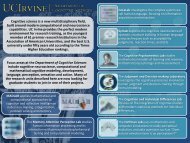Conscious Realism and the Mind-Body Problem - UCI Cognitive ...
Conscious Realism and the Mind-Body Problem - UCI Cognitive ...
Conscious Realism and the Mind-Body Problem - UCI Cognitive ...
You also want an ePaper? Increase the reach of your titles
YUMPU automatically turns print PDFs into web optimized ePapers that Google loves.
106 HoffmanHere <strong>the</strong>re is good news. We have substantial progress on <strong>the</strong> mindbodyproblem under conscious realism, <strong>and</strong> <strong>the</strong>re are real scientific <strong>the</strong>ories.We now have ma<strong>the</strong>matically precise <strong>the</strong>ories about how one typeof conscious agent, namely human observers, might construct <strong>the</strong> visualshapes, colors, textures, <strong>and</strong> motions of objects (see, e.g., Hoffman 1998;Knill <strong>and</strong> Richards 1996, Palmer 1999).One example is Ullman’s (1979) <strong>the</strong>ory of <strong>the</strong> construction of threedimensionalobjects from image motion. This <strong>the</strong>ory is ma<strong>the</strong>maticallyprecise <strong>and</strong> allows one to build computer-vision systems that simulate <strong>the</strong>construction of such objects. There are many o<strong>the</strong>r ma<strong>the</strong>matically precise<strong>the</strong>ories <strong>and</strong> algorithms for how human observers could, in principle,construct three-dimensional objects from various types of image motions(e.g., Faugeras <strong>and</strong> Maybank 1990, Hoffman <strong>and</strong> Bennett 1986, Hoffman<strong>and</strong> Flinchbaugh 1982, Huang <strong>and</strong> Lee, 1989, Koenderink <strong>and</strong> van Doorn1991, Longuet-Higgins <strong>and</strong> Prazdny 1980). We also have precise <strong>the</strong>oriesfor constructing three-dimensional objects from stereo (Geiger et al. 1995,Grimson 1981, Marr <strong>and</strong> Poggio 1979), shading (Horn <strong>and</strong> Brooks 1989),<strong>and</strong> texture (Aloimonos <strong>and</strong> Swain 1988, Witkin 1981). Researchers debate<strong>the</strong> empirical adequacy of each such <strong>the</strong>ory as a model of humanperception, but this is just normal science.Almost without exception <strong>the</strong> authors of <strong>the</strong>se perceptual <strong>the</strong>ories arephysicalists who accept HFD <strong>and</strong> conceive of <strong>the</strong>ir <strong>the</strong>ories as specifyingmethods by which human observers can reconstruct or approximate <strong>the</strong>true properties of physical objects that, <strong>the</strong>y assume, exist objectively,i.e., independently of <strong>the</strong> observer (a claim about physical objects thatis explicitly denied by conscious realism). But each of <strong>the</strong>se perceptual<strong>the</strong>ories can equally well be reinterpreted simply as specifying a methodof object construction, not reconstruction. The ma<strong>the</strong>matics is indifferentbetween <strong>the</strong> two interpretations. It does not require <strong>the</strong> hypo<strong>the</strong>sisof independently existing physical objects. It is perfectly compatible with<strong>the</strong> hypo<strong>the</strong>sis of conscious realism, <strong>and</strong> <strong>the</strong> mind-dependence of all objects.So interpreted, <strong>the</strong> large <strong>and</strong> growing literature in computationalvision, <strong>and</strong> computational perception more generally, is concrete scientificprogress on <strong>the</strong> mind-body problem, as this problem is posed by consciousrealism. It gives ma<strong>the</strong>matically precise <strong>the</strong>ories about how certain consciousagents construct <strong>the</strong>ir physical worlds. The relationship between<strong>the</strong> conscious <strong>and</strong> <strong>the</strong> physical is thus not a mystery, but <strong>the</strong> subject ofsystematic scientific investigation <strong>and</strong> genuine scientific <strong>the</strong>ories.What one gives up in this framework of thinking is <strong>the</strong> belief thatphysical objects <strong>and</strong> <strong>the</strong>ir properties exist independently of <strong>the</strong> consciousagents that perceive <strong>the</strong>m. Piaget claimed that children, at about ninemonths of age, acquire object permanence, <strong>the</strong> belief that physical objectsexist even when <strong>the</strong>y are not observed (Piaget 1954; but see Baillargeon1987). <strong>Conscious</strong> realism claims that object permanence is an illusion. It







